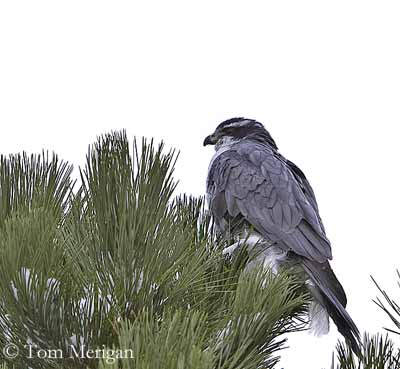
Text by Nicole Bouglouan
Photographers :
John Anderson
John Anderson Photo Galleries
Didier Buysse
Vision d’Oiseaux
Alfredo Colón
Puerto Rico Wildlife
Jean Michel Fenerole
Photos d’Oiseaux du monde
Steve Garvie
RAINBIRDER Photo galleries
Tom grey
Tom Grey's Bird Pictures
Patrick Ingremeau
TAMANDUA
René Lortie
http://rlortie.ca
Tom Merigan
Tom Merigan’s Photo Galleries
Niraj V. Mistry
Photo Galleries
Eugène Montocchio
Galerie Photos Nature
Bob Moul
Nature Photography
Jean Michel Peers
JMPN PHOTOGRAPHIE
Jean Marc Rabby
Des Ailes et des Plumes
Callie de Wet
GALLERY
Nicole Bouglouan
PHOTOGRAPHIC RAMBLE
Sources :
HANDBOOK OF THE BIRDS OF THE WORLD Vol 2 by Josep del Hoyo-Andrew Elliot-Jordi Sargatal - Lynx Edicions - ISBN: 8487334156
HAWKS, EAGLES AND FALCONS OF NORTH AMERICA by Paul A. Johnsgard - Smithsonian Institution Press - ISBN: 1560989467
GUIDE DES RAPACES DIURNES – Europe, Afrique du Nord et Moyen-Orient de Benny Génsbol – Delachaux et Niestlé – ISBN : 2603013270
BIRDS OF AFRICA SOUTH OF THE SAHARA by Ian Sinclair and Peter Ryan - Princeton University Press Princeton and Oxford - ISBN: 0691118159
ROBERTS BIRDS OF SOUTH AFRICA by G. R. Mc Lachlan and R. Liversidge – The Trustees of the John Voelcker Bird Book Fuund – ISBN: 0620031182
Chanting-goshawks, Goshawks, Sparrowhawks, Hawks
Genera Accipiter, Urotriorchis, Megatriorchis, Erythrotriorchis, Melierax, Micronisus
The sixth group of the Family Accipitridae includes about 59 species with usually uniform characteristics.
The large genus Accipiter contains 51 species ranging from the small African Little Sparrowhawk (Accipiter minullus) of about 75-85 grams, to the female Northern Goshawk (Accipiter gentilis) of 1400 grams.

Accipiter gentilis
The three genera Urotriorchis, Megatriorchis and Erythrotriorchis are living in tropical rainforest. They could be the first Accipiter species.
The Gabar Goshawk (Micronisus gabar) is closely related to Accipiter, but this species is more often related to the Chanting Goshawks of the genus Melierax, themselves being more similar to harriers.
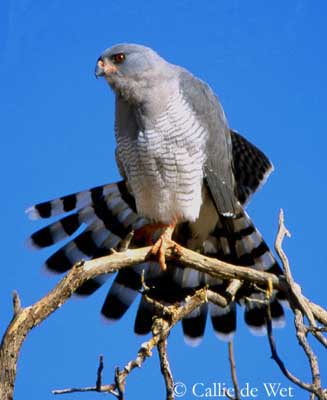
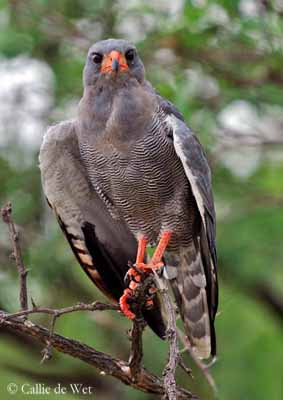
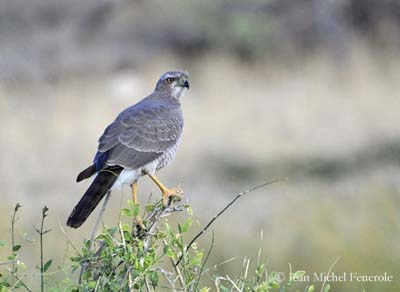
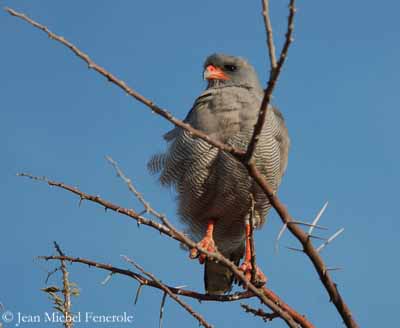
The raptors of the genus Accipiter occur all around the world except the poles. Most of the goshawks are found in sub-Saharan Africa, but some of them also in the Far East and in Australia.
The sparrowhawks have usually more restricted range, except the Collared Sparrowhawk (Accipiter cirrocephalus) from Australia, the Black Sparrowhawk (Accipiter melanoleucus) from sub-Saharan Africa, and the widespread Eurasian Sparrowhawk (Accipiter nisus) which occurs in Europe.
The other species are mainly confined on islands where they may be widespread in suitable, but restricted habitat.
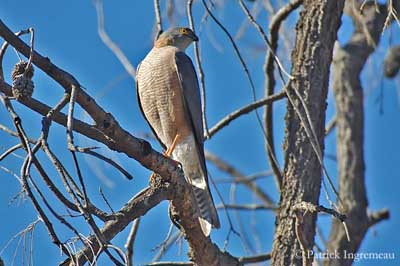
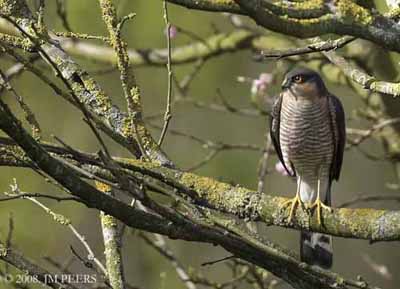
The raptors named “hawks” in the genus Accipiter are American raptors and occur in N, C and S America.
The other raptors, sparrowhawks and goshawks of the genus Accipiter occur in the other continents, Europe, Africa, Asia, Australia and islands.
They are medium-sized birds of prey with short, rather rounded wings. The body is slender. Their ability to manoeuvre in flight is due to their long tail. The wings are broad, with rounded tip. Several outer primaries are strongly narrowed by notching or emargination towards the tip. Actually, each outer flight feather is able to work alone, independently of the others. This kind of arrangement reduces the air turbulence and allows a low flight at stalling speed when they are pursuing preys.
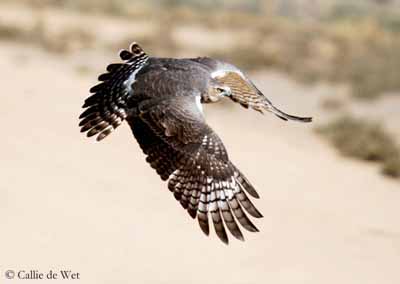
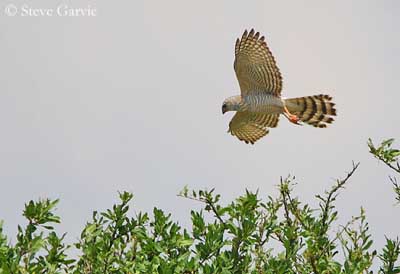
The females are often larger than the males. The relatively long legs are not feathered, yellow to orange, with slender and long toes equipped with sharp claws or talons. The bill is strong, hooked, adapted for tearing and pulling flesh.
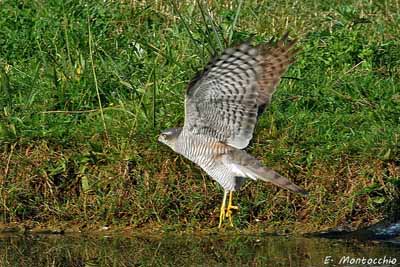
Accipiter nisus
The plumage is varied, with numerous combinations of grey, rufous, brown, buff, black and/or white. They often show pale underparts with dark bars, or rufous with white bars. The long tail is often barred, but the Melierax species have uniform blackish tail.
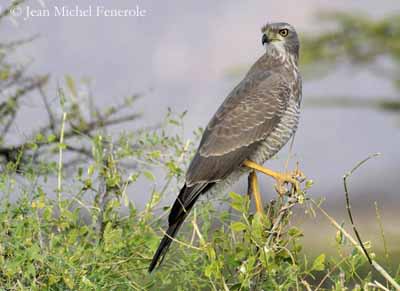
Eastern Chanting-goshawk
Melierax poliopterus
Immature
If the chanting-goshawks (Melierax) from Africa and Arabia, usually catches slow-moving preys on the ground, the hawks, the goshawks and the sparrowhawks (Accipiter) are specialized for hunting birds with aerial chases, including under woodland canopies. They fly with rapid wing-beats interspersed with glides, but they soar rarely. They are able to perform great bursts of speed with such wings.
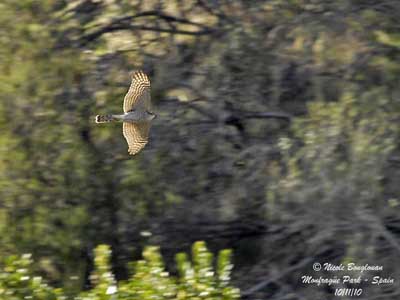
The three chanting-goshawks of genus Melierax, Dark Chanting-goshawk (Melierax metabates), Eastern Chanting-goshawk (Melierax poliopterus) and Southern Pale Chanting-goshawk (Melierax canorus) hunt mainly from a perch and swoop down for prey on the ground. They occasionally may pursue a prey on foot if necessary.
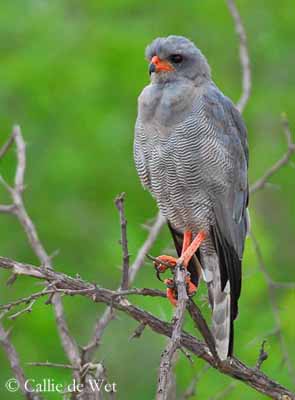
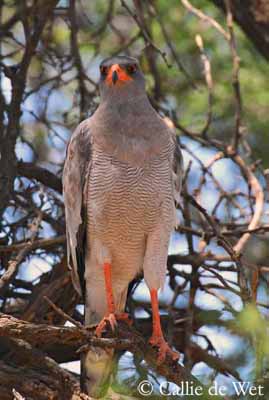
Melierax metabates
Southern Pale Chanting-goshawk
Melierax canorus
The Gabar Goshawk (Micronisus gabar) hunts like the Accipiter from within the cover, from where it makes fast dashes after a prey, even continuing on foot. But it also performs low flights, searching for preys, birds’ nests, small reptiles, rodents and large insects, as the chanting-goshawks.
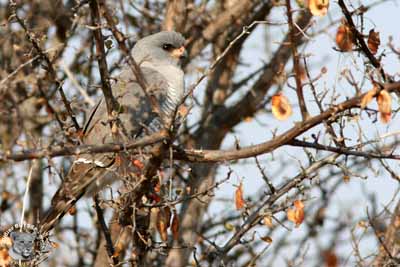
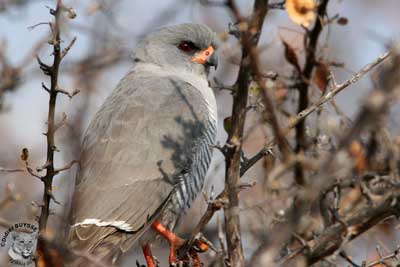
These raptors perform aerial displays before to nest. They call from perches, often treetops. The Eastern Chanting-goshawk performs communal aerial displays at night, and calls on moonlight nights. The Southern Pale Chanting-goshawk utters melodious whistles from an exposed perch with fanned tail.
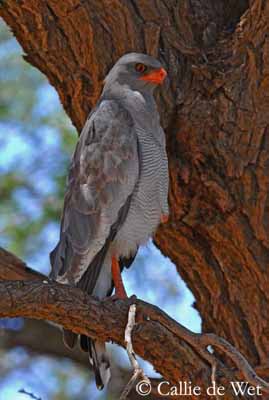
Southern Pale Chanting-goshawk
Melierax canorus
They build a platform in tree with sticks, and lined with dung, dry grass and debris. The Dark Chanting-goshawk and the Gabar Goshawk’s nests are covered in spiders’ webs, probably for better camouflage.
They are territorial and defend strongly the nest-site, being sometimes very aggressive towards the intruders. Threatening display flights with jerky, flapping flight and gliding approach are some of the threat displays used by these raptors.
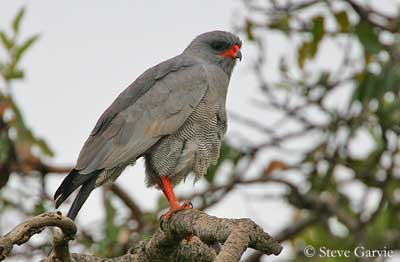
Dark Chanting-goshawk - Melierax metabates
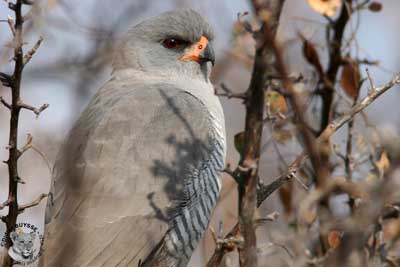
The female lays usually 1-2 eggs, but the Gabar Goshawk may lay 2-4 eggs. The incubation lasts between 30 and 35 days, mainly by the female. The male often feeds her during this period.
The chicks have white or grey down, with long filaments on the head. They are fed by both parents and fledge between 35 and 50 days after hatching, according to the species.
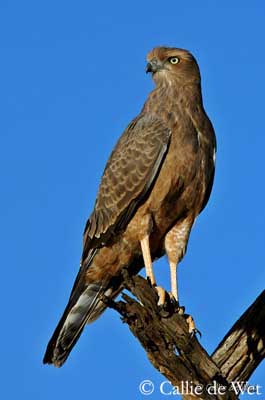
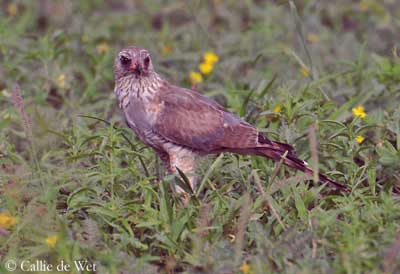
Southern Pale Chanting-goshawk
Melierax canorus - Juvenile
Juvenile
They are mainly resident, but some migratory movements may occur in dry season. The young birds are often nomadic.
They are found in sub-Saharan Africa and Arabia, mainly in South Africa for the Southern Pale Chanting-goshawk, and in the eastern part for the Eastern Chanting-goshawk.
These raptors are relatively common and widespread in suitable habitat and currently, their populations appear stable and not globally threatened.
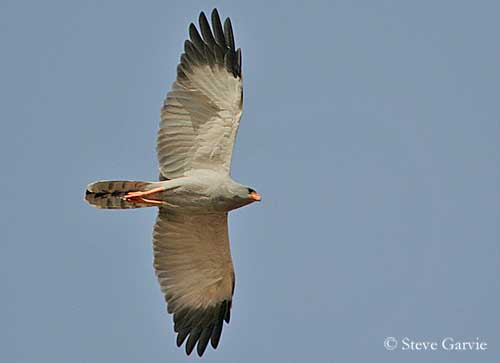
Melierax metabates
Genus Accipiter
The genus Accipiter includes 51 species from the whole world, goshawks, sparrowhawks and hawks, often known as the “true hawks”.
The raptors of this genus are usually medium-sized, but the Northern Goshawk (Accipiter gentilis) is the largest, and mainly the female. Usually, these birds of preys have short, rounded wings and long tail, and are fast fliers.
They hunt from cover in wooded and bushy areas, and dash after preys, taking advantage of the surprise to kill their victims. Their keen vision allows them to detect easily small rodents, birds, large insects or fish.
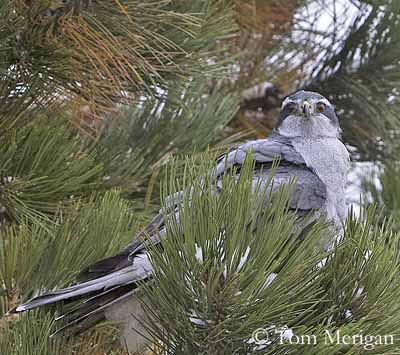
Accipiter gentilis
The Accipiter species have bill and feet adapted to killing, tearing and carrying the food.
Their wings allow them to reach great speed when pursuing some bird while flying. They have high manoeuvrability in flight, and especially through the trees and branches when hunting in woodlands and under the canopy.
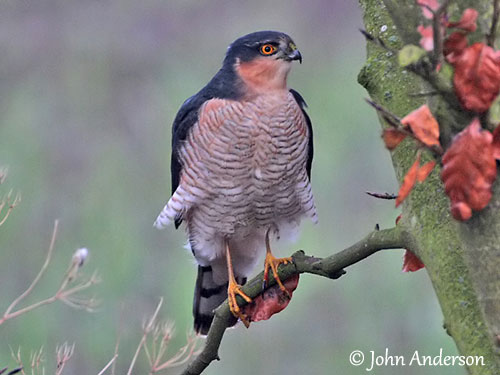
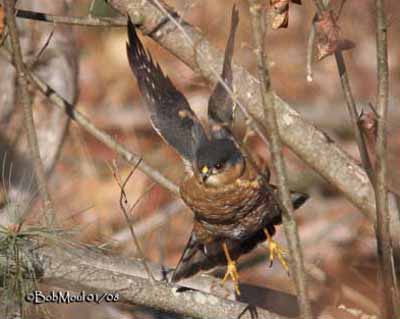
They often hunt from a concealed perch from which they perform short, rapid flight. The prey is caught by surprise in flight, on the ground or from the vegetation. They also fly low and fast, searching for preys on the ground. Once the prey is detected, they dive, or perform direct flying attack, sometimes ending in short chase.
They are able to attack a bird in flight, by direct attack, fast coursing, stooping from high soaring flight, or after glide and chase.
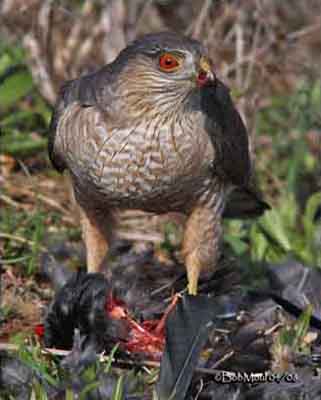
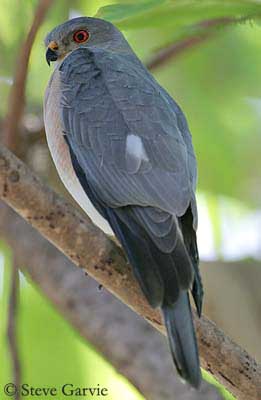
The Northern Goshawk (Accipiter gentilis) approaches with flapping flight until the prey is some metres away. Then the raptor glides, and about two metres before to take the prey, the feet are lowered and the toes partially flexed. The impact is made with legs held out in front, and toes fully extended. At this time, wings and tail adopt a braking position. The prey is caught and killed with the talons.
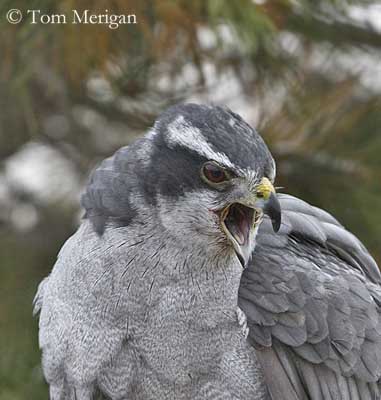
Accipiter gentilis
The Accipiter raptors usually feed on small or medium-sized mammals, birds (from sparrows to grouses), bats, lizards, frogs, some reptiles, and large insects such as grasshoppers and beetles.
They hunt within woodlands and among vegetation, in clearing, at forest edges, in open areas, according to the range and the habitat.
They are active at dawn or dusk, in the early morning and the late afternoon, but usually they rest during the mid-day hours.
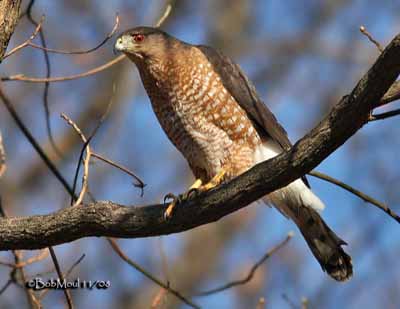
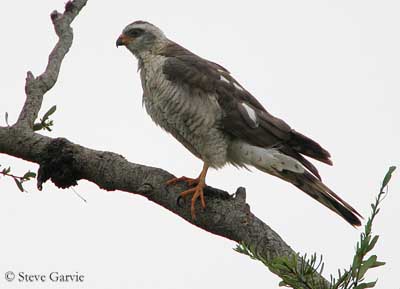
The Accipiter species are territorial. The resident birds defend their area all year round, and chase away the intruders by direct flight and glides towards them. The (re)establishment of the territory includes advertising behaviour by the owner, conspicuous perching and calling, and aerial displays in the surrounding of a potential nest-site.
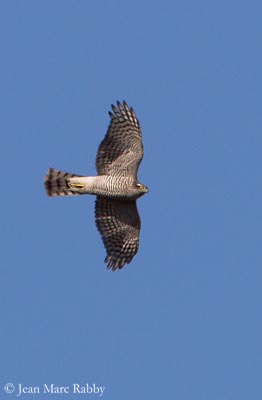
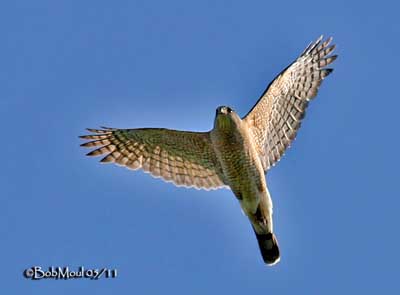
The courtship displays are performed above or close to this place. Male and female fly together and chases are observed. The flight is often undulating, with some dives by the male.
The mates roost, call and fly together. The male often feeds the female and they select a nest-site. Then, they bring nest material and copulation occurs.
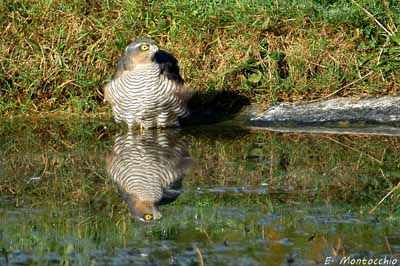
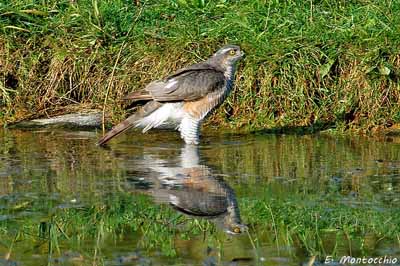
The nest is built in trees, often near the forest edge. It is a platform made with sticks and lined with green leaves and both sexes usually share this work.
The female lays 2-3 eggs, sometimes more according to the species. Incubation lasts between 30 and 35 days, often by both adults. The chicks are covered in white down. They fledge about 27-32 days after hatching. They depend on parents for several weeks before to become independent.
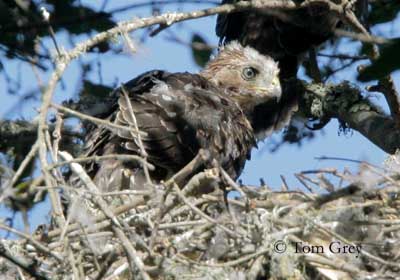
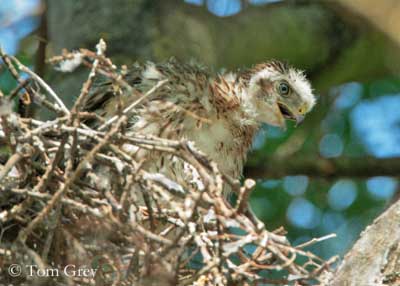
Most of the goshawks, sparrowhawks and hawks of genus Accipiter are mainly resident, but some species such as Cooper's Hawk (Accipiter cooperii), Shikra (Accipiter badius), Levant Sparrowhawk (Accipiter brevipes), Chinese Goshawk (Accipiter soloensis), Japanese Sparrowhawk (Accipiter gularis), Eurasian Sparrowhawk (Accipiter nisus), Sharp-shinned Hawk (Accipiter striatus) and probably some others are migratory.
Usually, adults are resident whereas the young birds perform some movements or migrations. Altitudinal movements are also recorded, according to the range.
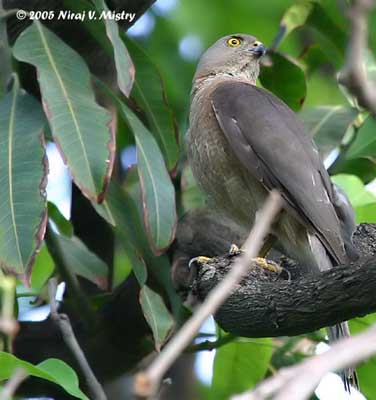
Accipiter badius
They are found in all parts of the world, except the poles. They can be common in suitable habitat, but all the species are threatened by deforestation and habitat loss, disturbances in breeding grounds, persecution in some countries, poisoning by pesticides…
These birds of prey are often unobtrusive and difficult to see. Several species have probably fairly stable populations, but the large range and the dense habitat do not allow good observation.
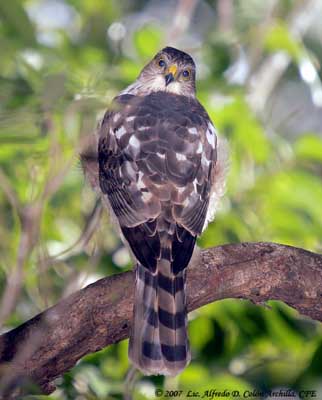
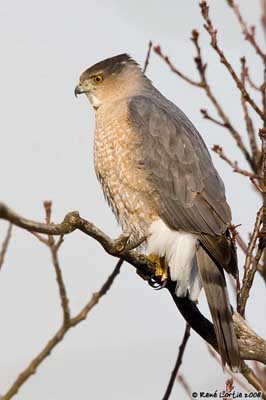
Goshawks, sparrowhawks and hawks of genus Accipiter are beautiful birds of prey. They are fast fliers and good hunters. We enjoy their presence and their spectacular aerial displays, in spite of their “cruelty” towards several birds and mammals’ species. They feed on living preys and have to kill them. But this is more natural than to die by gun shot!
The sixth group of the family Accipitridae still includes four species of three genera.
The first genus, Erythrotriorchis, has two species: the Chestnut-shouldered Goshawk (Erythrotriorchis buergersi) from N and E New Guinea, and the Red Goshawk (Erythrotriorchis radiatus) from N and E Australia. Both have formerly been merged into Accipiter before to have their own genus.
The Chestnut-shouldered Goshawk has rather short wings. The upperparts are chestnut with blackish spots, dark flight feathers and barred tail. The underparts are white streaked black. The head is dark grey to blackish on forehead, crown and nape, whereas face, chin and cheeks are white. The bill is black with yellow cere. Eyes, legs and feet are yellow.
This inhabitant of the lower montane rain forests feeds mainly on birds. It hunts from a perch in tree, and performs direct flight attack at the prey. It also may hunt by soaring. It can be seen from 450 to 1600 metres of elevation.
The nesting behaviour is unknown.
This species is very rare with low population densities, and probably threatened by deforestation.
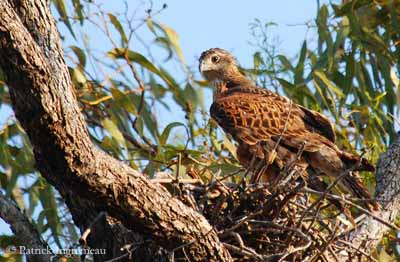
Red Goshawk
Erythrotriorchis radiatus
The Red Goshawk has longer wings and more rufous plumage on the lower underparts. The upperparts are rufous-brown with blackish spots. The tail is barred. The head is white with black streaks, as the throat and the upper breast. It has an occipital crest. The bill is black with grey cere. The eyes are pale yellow. The powerful legs and feet are yellow.
This raptor is found in open forests in coastal and sub-coastal regions, and can be seen from sea-level up to 1000 metres of elevation.
It feeds mainly on birds such as pigeons, parrots and even ducks and herons. It takes rarely mammals, but may catch some reptiles and large insects.
It forages from a concealed perch where it stays for short time, in the early morning and the late afternoon. It performs long glides or flapping flight, as well as low flight near the ground or above the canopy. It may catch a bird while flying after a glide, or by direct attack followed by fast chase. It also stoops on prey from the air.
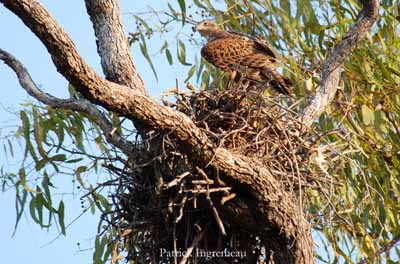
Red Goshawk
Erythrotriorchis radiatus
The Red Goshawk is solitary nester and usually monogamous.
The nest is placed in tall tree, between 15 and 30 metres above the ground, in forest or woodland near water. It is a platform made with sticks and lined with green leaves.
The female lays two eggs and the incubation lasts about 39-43 days. The chicks are covered in white down and fledge at 51-53 days of age. They still depend on parents for 10-11 weeks after fledging.
The nest and the chicks can be sometimes destroyed by bush fires.
The adults are sedentary, but the juveniles perform some dispersion up to 500 kilometres from the breeding grounds.
This species is rare and vulnerable, and threatened by clearing and fragmentation of its forested habitats for agriculture expansion. It is endangered in some Australian regions.
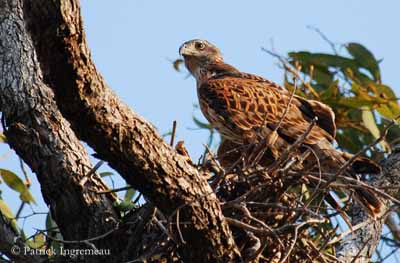
Red Goshawk
Erythrotriorchis radiatus
The genus Megatriorchis includes only one species, the Doria’s Hawk (Megatriorchis doriae) from New Guinea. It has often been merged into Accipiter before to get its own genus.
This hawk is medium-sized with a length of 51-69 centimetres and a weight of 1000 grams for the large female.
Upperparts and head are brown, heavily spotted blackish, mainly striated on the head where we can see a kind of dark “mask” on the rear of the eyes. The tail is brown barred black.
The underparts are white with rufous steaks on throat and breast, and white belly with faint pale brown streaks. The bill is grey with grey cere. Eyes are yellow. The pale yellow legs and feet are powerful like Accipiter, but the wings are shorter.
This hawk is probably sedentary in lowlands, rain forest and mangroves where it is living. It can be seen from sea-level up to 1650 metres of elevation.
The Doria’s Hawk feeds on birds such as Lesser Bird-of-paradise (Paradisaea minor) and takes some preys from the foliage. It perches for long periods inside the forest canopy, waiting for preys at good sites such as flowering trees or bird-of-paradise leks. It can be seen flying at forest edge or just above the canopy.
The breeding and nesting behaviours are unknown.
This species is scarce are rare, probably threatened by deforestation.
The latest genus of the sixth group is the genus Urotriorchis, with only one species, the Long-tailed Hawk (Urotriorchis macrourus) from Liberia to W Uganda and to SW and C Zaire, Africa.
This genus is closely related to Accipiter, and has also been linked with Melierax, and also Kaupifalco (which is part of the following seventh group). Its aspect of plumage and behaviour is fairly similar to Melierax.
This elegant hawk has grey head, brown-grey upperparts with white rump, and rufous underparts except the white undertail-coverts. The long graduated tail is blackish with large white spots.
The bill is grey with pale yellow cere. Eyes, legs and feet are yellow.
It frequents the lowland tropical evergreen forests and the adjacent gallery forests. It is resident in its range.
The Long-tailed Hawk feeds on small mammals such as squirrels, rodents and bats, but it also takes some birds. It breaks the neck of its victims to kill them.
Its long tail allows it to pursue easily the birds in flight, including among the branches. It hunts in the low understorey, sometimes near the ground, but also in the canopy.
Its presence is revealed by calling within the forest.
The breeding and nesting behaviours are poorly known. The nest is built in tall tree by both adults.
This species is relatively common in primary forest and occurs readily at the edges of clearings. It is threatened by deforestation.
The sixth group of the Family Accipitridae includes several genera but with some similar hunting and breeding-nesting behaviours, type of preys and usual habitats. Small to medium-sized birds of prey, they have similar appearance in spite of different plumage colours.